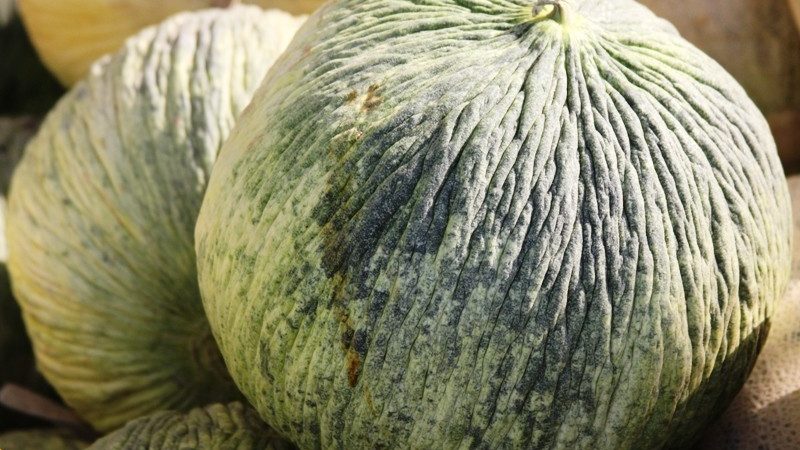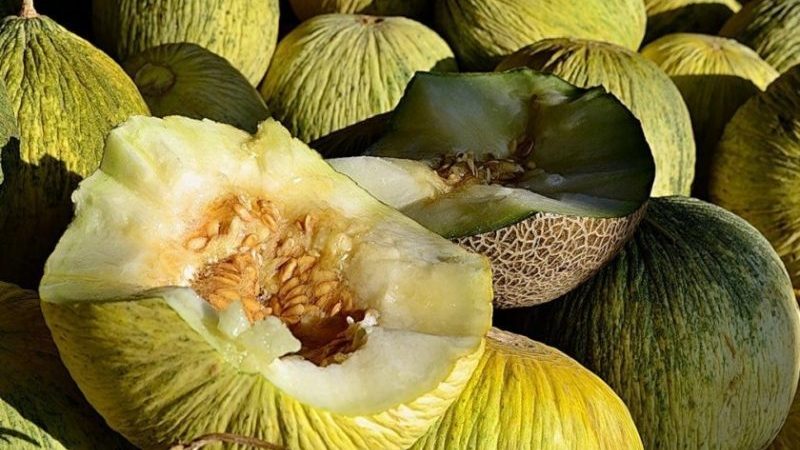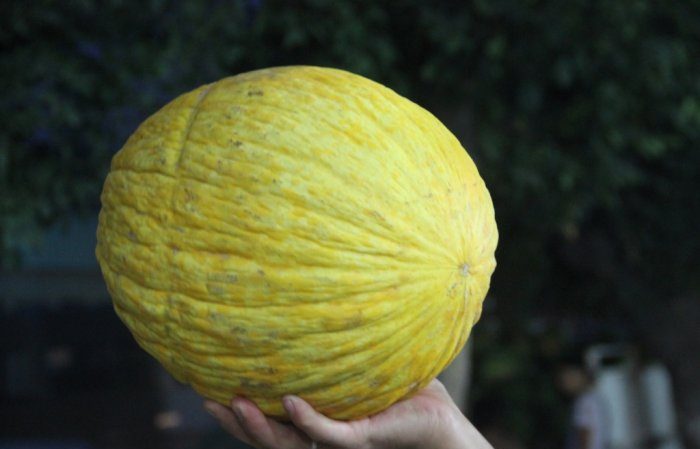Uzbek autumn melon "Babushka"
Melon Granny attracts attention with its unusual appearance. It is very different from the fruits we are used to. Grandmother, Old Maid, Old Woman, Kampir Kovun - these are just a few of her other names.
Delicious, aromatic, useful, it ripens in autumn and pleases with its fruits from September to December. They buy it when other fruits of this culture are already disappearing from store shelves. Let's get to know her in more detail and find out why she is so good.
The content of the article
Description
For wrinkledness, the melon is called "kampir kovun" (sometimes - "kampir kovun"), or the melon grandmother. Scientific name - Cucumis melo ssp. orientale Sageret var, or "Dutma". Its homeland is Asia, now it grows in the Syrdarya and Samarkand regions.
It belongs to the Uzbek branch of the pumpkin. It was bred back in the Middle Ages and received the name "Kampir", which means "grandmother" in Uzbek. This name suits her perfectly. The skin of the fruit is tough, covered with deep grooves, reminiscent of senile wrinkles.

Distinctive features
In addition to its appearance, a distinctive feature of the variety is its late ripening. In Asia, these melons are harvested only in September. If you decide to grow it in Russia, then it will mature even later.
Melon has an unusual taste, similar to melon, cucumber and pumpkin at the same time with a fresh aroma. This is a real delicacy from the east, which is rare in our country - it is difficult to transport Grandma and she is poorly stored.
Composition and properties
In addition to the original look and unusual taste, the Kampir variety contains micro- and macroelements, vitamins and minerals. Late varieties of melons are considered the lowest in calories and help fight cholesterol and diabetes.
Nutritional value of Babushka variety per 100 g:
- water - 88.5 g;
- proteins - 0.6 g;
- fats - 0.3 g;
- carbohydrates - 10.3 g;
- dietary fiber (fiber) - 0.6 g;
- pectins - 0.4 g;
- organic acids - 0.12 g;
- ash - 0.5 g;
- energy value - 38-42 kcal, depending on ripeness.
Vitamins, mg:
- A (beta-carotene) - 0.4;
- B1 (thiamine) - 0.04;
- B2 (riboflavin) - 0.04;
- B3 (vitamin PP) - 0.4;
- B9 (folic acid) - 0.006;
- C (ascorbic acid) - 20;
- E (tocopherol) - 0.1.
Macronutrients, mg:
- potassium - 118;
- sodium - 32;
- calcium - 16;
- magnesium - 13;
- phosphorus - 12.
Trace elements, mcg:
- iron - 1000;
- zinc - 90;
- copper - 47;
- manganese - 35;
- fluorine - 20;
- iodine - 2;
- cobalt - 2.
Useful properties of Kampir Kovun:
- strengthens the immune system;
- promotes the regeneration of blood cells;
- normalizes hemoglobin;
- has a positive effect on the heart and cardiovascular system;
- thins the blood and promotes the resorption of blood clots;
- cleans the digestive tract;
- improves bowel function;
- flushes the kidneys, adrenal glands and urinary system;
- helps prevent the formation of kidney stones;
- improves intestinal microflora;
- has a positive effect on the brain and nerves.
There will be no harm from melon if you do not eat it in large quantities. When overeating is observed:
- bloating;
- gassing;
- loose stools.
Fruit characteristics and yield
Melon yield - 2.3-3.1 kg per 1 m². Fruits weighing 2-3 kilograms, up to 30 cm in diameter. Covered with a tough, dense crust resembling wrinkles. The skin color is from gray-green to green-yellow.
There is a bulge near the peduncle that looks like a cone or cap.
The pulp is light, white around the peel, light orange in the center of the seeds, juicy and watery.The juice of this melon is useful, it is better to collect and drink when cutting.
How to choose fruits when buying
When buying, remember the ripening time of the variety. It's useless to look for Grandma on the shelves in July. It should be borne in mind that, even if the melons were removed from the melons unripe, then at a temperature of + 30-40 ° C they quickly ripen, deteriorate and rot.

Secrets of choosing ripe melon:
- The surface of ripe Granny melon is uniformly light green, pale. The dark green color on it indicates that the melon is not ripe, rich yellow - that it is already overripe, if there are brown spots - it begins to rot. In order not to be mistaken, it is worth looking at a photo of a ripe melon on the Internet in advance. It is better not to buy cracked or scratched ones - in these places dirt accumulates and microbes develop.
- If veins are visible in the cut, the fetus was overfed with nitrates and fertilizers. They are also indicated by a yellowish stripe between the peel and flesh. The green bar indicates immaturity.
- Farmers often treat plants with urea. A sign of this is the beautiful appearance of the fruit: glossy peel, no smell on the outside, but a strong aroma on the inside.
How to grow yourself
To feast on Granny, you will have to grow her yourself, because you won't be able to bring melon from the south. To get a good harvest, the nuances of planting and care are observed.
Growing in stages and care
Planting begins with choosing a place to plant. In the garden for melon beds, it is recommended to take the southern, sunny side of the site. If you plant in open ground, that plant needs to be equipped with warm beds. Melon does not like acidic soils. Reduce acidity with wood ash added to the soil.
It is advisable to conduct electricity into the greenhouse so that the bushes receive light even in bad weather. Due to the limited space, you will have to equip vertical beds and raise the whips.
It is impossible to plant melons and gourds in the same place for two years - they observe the rules of crop rotation. Best melon predecessors:
- cabbage;
- beans;
- beet;
- potatoes;
- onion.
Granny is planted when the risks of spring frosts have passed. The exact time depends on the weather conditions and the region. It is wise to postpone planting in soil until mid-May. Water for irrigation must have a temperature not lower than + 20 ° С. In the central and northern regions, melons are grown using seedlings.
The seeds are heated on a battery or dipped in hot water, treated for diseases and pests.
Sow them to a depth of 10-12 cm. The distance between the bushes should be from 70 cm, but it is better to leave one meter at a time. Melon roots creep along the ground and go deeper, they need a lot of space. It is difficult to create such conditions in the greenhouse due to the lack of space.
Important! After planting in open ground, the crop needs additional protection from the wind. To do this, it is fenced off with low fences made of plastic or cardboard.
Water the plant 1-2 times a week in the heat and less often if there is precipitation. To do this, use a drip system or sprinkler. If this is not possible, then use warm water that has been settled for 24 hours.
Council. Be sure to monitor the condition of the soil. Do not pour over the melon - this will cause the roots to rot.
In temperate climates, growth accelerators are used for melons, which can be nitrogen-containing fertilizers. They are used no more than once a month. If you do this more often, the fruits will accumulate nitrates, lose their beneficial properties and become unpleasant to the taste.
In addition to nitrogen, potash and phosphorus fertilizers are applied monthly before harvesting.
For a good harvest, it is important to form bushes and remove weak shoots. No more than five lashes are left on one plant. This procedure is carried out so that the bush does not waste energy on the growth of the stems, but transfers them to the fruit ovary.
The soil is weeded and loosened after each watering. Young plants need mulching.
If the melon is planted in a greenhouse, then artificial pollination and the formation of lashes on the trellises are additionally carried out.
Diseases and pests
Melon Kampir is susceptible to the following diseases:
- fusarium - the bushes are treated with a solution of potassium chloride or superphosphates;
- powdery mildew - disinfected with a solution of sulfuric acid;
- Copperhead - shoots are sprayed against it with 1% Bordeaux liquid.
These measures are combined with preventive treatment of seeds before planting with solutions of formaldehyde or potassium permanganate. Damaged shoots are destroyed at the first signs of the disease.
In addition to diseases, insects can also harm melons:
- melon aphid;
- wireworm;
- melon fly;
- spider mite.
Measures to combat them:
- treatment with soapy water (100 g of grated soap per 10 liters of water);
- the use of "Karbofos" (60 g per 8 liters of water);
- adding "Bazudin" to the soil before planting (mix 15 g with 0.5 liters of river sand and distribute over a hundred square meters of land).
Harvesting and application of the crop

The crop is harvested even in Uzbekistan in autumn, not earlier than September. The ripeness of the fruit is determined by the dried tail and the color transition from light green to yellow.
Since storage of melons of this variety is poorly tolerated, it is recommended that they be eaten immediately or preserved in the form jam, jams, preserves.
Storage
Proper storage involves wrapping the fruit one at a time in nets and hanging them. Melons should not come into contact with walls or other fruits.
The fruits can be stored in hay, sand, straw, creating an additional substrate for them. But even this method does not allow to preserve the Granny melon longer than the prescribed period.
Important! Approximately two months after removing the melon from the ridge, Kampir begins to rot even if all storage conditions are met.
Advantages and disadvantages
Benefits of the Granny variety:
- unusual appearance;
- ease of cultivation, which does not require special knowledge from beginners;
- unusual taste.
Disadvantages of the variety:
- sometimes the disadvantages include an unusual taste - due to the fact that it is not very similar to the one we are used to;
- poor keeping quality.
The main disadvantage is the problem of transportation and storage. It is solved by growing melons in your area.
Conclusion
Melon grandmother is an unusual variety, which until recently could only be tasted in Central Asia. This is due to the difficulties of its transportation and storage. Now the problem has been solved due to the possibility of growing the variety in greenhouses in different regions of our country. Granny is a late variety that you can enjoy in autumn. The taste is not for everybody, but the melon will definitely not leave you indifferent.